 Golden phoenix at Kinkakuji |
I won't write about Kyoto's major sights -- you can easily find thousands of sources online. Instead I'll write something more on the practical side -- a list of essential trip-planning considerations and solutions based on my own experience.
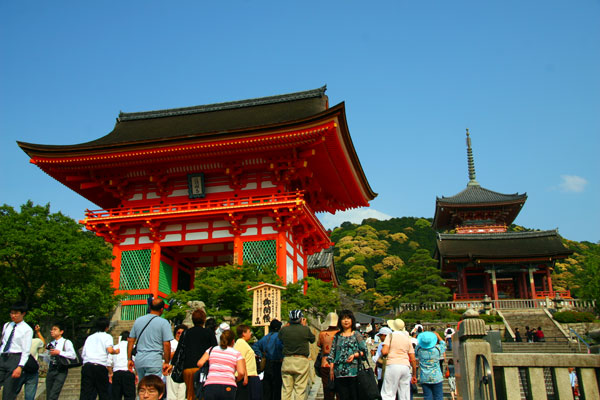 Entrance to Kiyomizudera |
READY-TO-USE ITINERARIES
One Day Itinerary:
Kyoto Station - buy City Bus Day Pass (500 yen) - take Bus 205 to Kinkakuji - See Kinkakuji - Take Bus 12 to Higashiyama - have lunch at Gion District - walk to Yasaka Jinja - see Ninen-zaka and Sannen-zaka - walk to Kiyomizu Dera - take Bus 206 back to Kyoto Station - dinner and shopping at Kyoto Station.
 Torii Tunnel at Fushimi Inari Shrine |
Three Day Itinerary:
Day 1 - Same as One Day Itinerary
Day 2 - Kyoto Station - take JR train to Inari Station (190 yen) - walk to Fushimi Inari Shrine - take JR train to Umahori (400 yen) - take Sagano Scenic Railway to Arashiyama (600 yen) - see Tenryuji - walk towards Saga - see Otagi Nenbutsuji and/or Adashino Nenbutsuji - walk to Saga Torii-moto - take Kyoto Bus #72 back to Kyoto Station (270 yen)
Day 3 - Kyoto Station - buy City Bus Day Pass (500 yen) - take Bus 9 to Nijo Castle - see Nijo Castle - take bus 101 to Shijo-Karasuma - lunch and shopping along Shijo street - walk or take any bus along Shijo to Shijo-Kawaramachi - walk across and/or along the Kamo River - take Bus 207 to Sanjusangendo - see Sanjusangendo - take Bus 100 or 206 back to Kyoto Station
 Old Scooter near the 5-Storey Pagoda |
Five Day Itinerary:
Day 1 to 3 - same as Three Day Itinerary
Day 4 - spend the day in Uji (see separate article on Uji -- you'll thank me)
Day 5 - So many choices -- Pre-arrange for a tour of Kyoto Imperial Palace or any one of the other Palaces (Katsura Rikyu or Shugaku-en Rikyu), or go for a hike from Kurama to Kibune in northeast Kyoto, or take the Hieizan Railway to see Enryakuji.
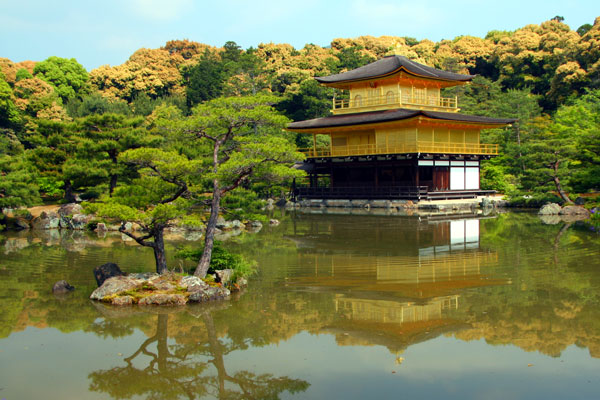 Kinkakuji -- the Golden Pavilion |
ARRIVAL
If you're coming from Tokyo on a grand tour of Japan, then you should already know about the JR Pass. It's less than two and a half hours taking the Shinkansen train.
If you're flying into the Kansai region, Kyoto has no international airport of its own so you'll mostly likely arrive at Kansai International Airport (IATA: KIX) just south of Osaka. There is a direct Limited Express train (nicknamed "Haruka") connecting to Kyoto. It takes 75 minutes and regularly costs 2980 yen (CAD$30).
 A Monk on the Path to Kiyomizudera |
But you can get a substantial discount by buying a "JR West Kansai Area Pass" for 2000 yen, which covers the unlimited use of Haruka, Rapid, and Local trains within the Kansai area including Kansai Airport, Osaka, Kyoto, Nara, Kobe, and all the way to Himeji. You can buy this pass at any JR Ticket Office at the Kansai Airport or any other major JR stations in the Kansai Area.
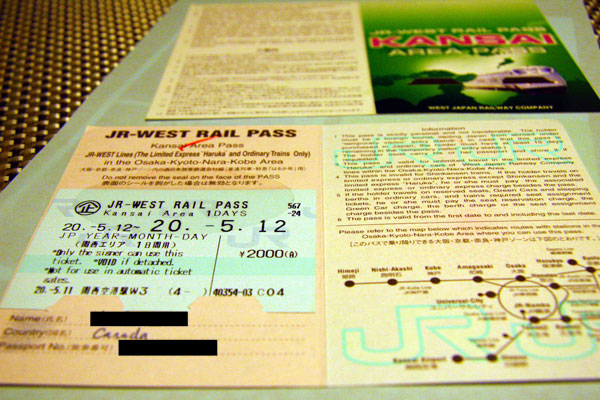 JR West Kansai Area Pass |
You can find out the official rules for the pass from the JR West Official Site.
[PRACTICAL TIP]: By the official rules you are supposed to buy only one JR Rail Pass of any type during one visit to Japan, so one staff will refuse to sell you more than one JR West Pass. But if you buy two JR West Pass from two different stations then they won't notice.
 Maiko (apprentice Geisha) perhaps ... but intuition tells me they're just dressed-up tourists |
TRANSPORTATION
In Kyoto, the City Bus system rules. Enough said.
There IS a subway system, but it doesn't reach many of the major sights (eg.Golden Pavilion, Fushimi Inari Shrine ("fox shrine"), Arashiyama etc). IMHO the subway is best for connecting between JR's Kyoto Station and your hotel so you don't have to drag your luggage onto a crowded bus. But for general sightseeing purpose you can get almost anywhere once you familiarize with the City Bus system.
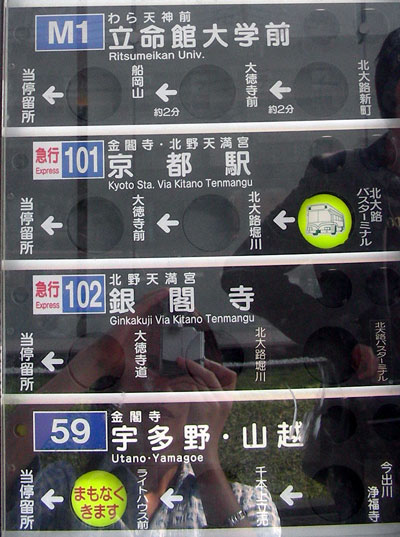 Information Panel at a City Bus stop |
City Bus
There must be a hundred or so routes, so I will list only the one I found to be particularly useful:
- 4: Kyoto Station - Kawaramachi-Sanjo (shopping) - Shimogamo Jinja - Kamigamo Jinja
- South 5: Kyoto Station - Fushimi Inari shrine ("fox shrine")
- 12: Gion - Nijo Castle - Kinkakuji (Golden Pavilion)
- 59: Shijo-Keihan Station (near Gion) - Kinkakuji - Ryuanji
- 100: Kyoto Station - Sanjusangendo temple - Kiyomizu Dera temple - Gion District - Heian Jingu - Ginkakuji temple
- 205: Kyoto Station - Kawaramachi-Sanjo - Shimogamo Jinja - Kinkakuji
- 206: Kyoto Station - Sanjusangendo temple - Kiyomizu Dera temple - Gion District
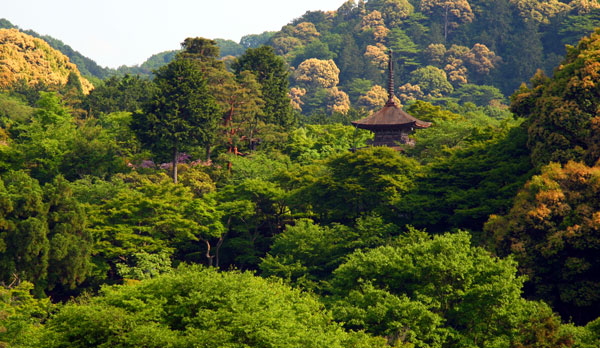 Early Summer at Higashiyama (Eastern Hills) District |
For a full list of routes, you can download the latest bus map from the City of Kyoto's official site.
It costs 220 yen everytime you get off a bus, so the relatively cheap Day Pass for 500 yen has become a favorite to tourists. Buy all the Day Passes you need for your entire stay in Kyoto when you arrive at Kyoto Station, or you risk boarding a bus with all its Day Passes sold out.
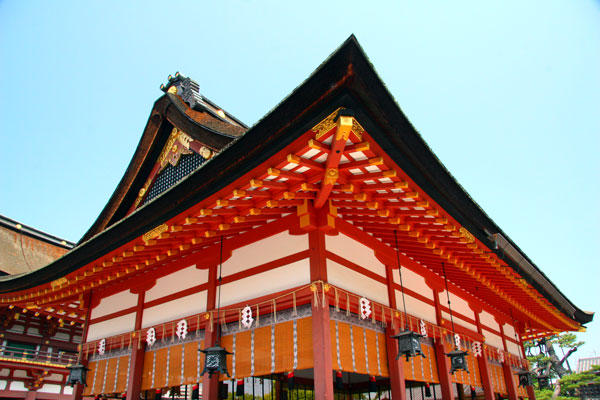 Inside Fushimi Inari Shrine Complex |
Kyoto Bus
This is a private bus company, entire separate from the City Bus system. For casual tourists this is only useful for reaching the outskirt areas not served by City Bus. Useful routes include:
- 17: Kyoto Station - Sanjo-Keihan (near Gion) - Ohara
- 18: Kyoto Station - Higashiyama-Sanjo (near Gion) - Ohara
- 62: Sanjo-Keihan Station (near Gion) - Arashiyama - Saga
- 72: Kyoto Station - Arashiyama - Saga
Fares are generally within the 300 yen range. I took #62 from Nijo to Saga for 270 yen.
PRACTICAL TIP
Kyoto Bus #62 / #72 is my preferred way to get to the Arashiyama area -- if you stay on the bus after Arashiyama the bus takes you deep into an amazingly beautiful area known as Saga. From Saga you can take a scenic walk back to Arashiyama which should take about an hour if you don't stop. It took us four hours -- so you can imagine how nice it was. But MAKE SURE you get on KYOTO BUS #62/#72, not the City Bus!
 Kiyomizudera -- a Candidate for the New 7 Wonders of the World |
Subway
Great for connecting between these places:
- Kyoto Station (the city's major train station)
- Nijo Castle (Nijojo-mae Station)
- Shijo-Karasuma shopping district (Shijo Station)
- Gion District (Higashiyama Station)
- Daigoji Temple (Daigo Station)
And not much else...
Fares depend on the distance of travel, starting from 210 yen and goes up to 340 yen. Day Pass costs 600 yen and is valid only in the Subway.
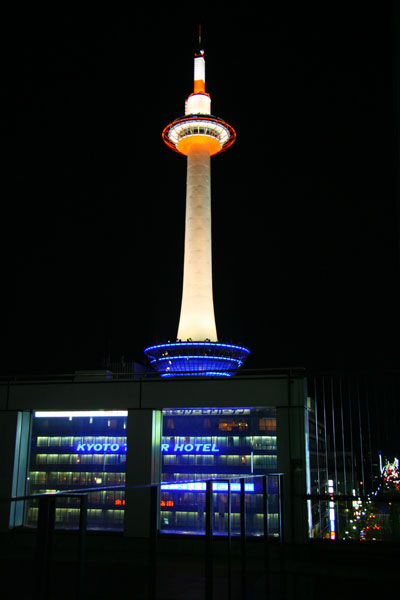 Kyoto Tower -- an Eyesore or a Landmark? |
JR Trains
Though mostly used for inter-city connections, the JR is useful for getting between certain outlying areas of Kyoto. For instance it connects between Umahori, Arashiyama, Nijo Castle, Kyoto Station, Fushimi Inari Shrine, and all the way to Uji, Nara and beyond. A couple of real-life examples we encountered:
1) The end point of the Sagano Scenic Railway lies in Kameoka/Umahori, on the far western side of Kyoto beyond Arashiyama, and the JR is the cheapest (320 yen) and most convenient way to get back to Kyoto Station.
2) One day we took the JR from Nijo to Inari to see the fox shrine, and it took 190 yen and less than 20 minutes. By City Bus it would have taken two bus trips and at least 45 minutes.
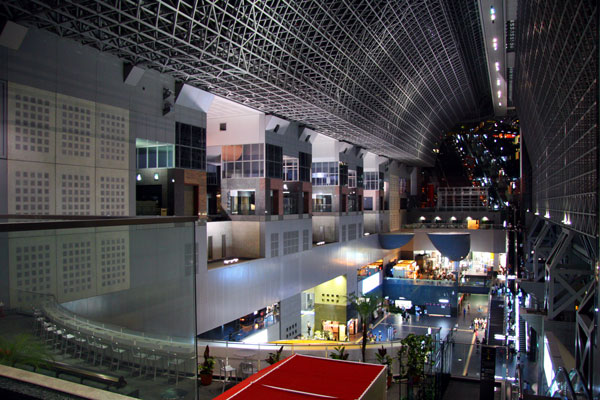 The Ultra-Modern Kyoto Station |
Keihan Railway
These little private trains runs down the Eastern bank of the Kamo River. To most tourists the only usage is to get from the Gion area (Sanjo-Keihan Station) to Fushimi Inari Shrine (Fushimi Inari Station) and possibly all the way to Uji.
A trip between Sanjo-Keihan and Fushimi Inari costs just 200 yen, slightly cheaper than the bus and much more convenient.
 "7 Falls and 8 Rises ... That's Life," says the little statue |
Keifuku Railway
Another little private railway, this one mainly for getting to Arashiyama which isn't served by the City Bus. The problem is none of its stations connects you to subway stations or major JR stations, so its use is really quite limited unless you really plan on getting to one of its stations by City Bus.
 Prayer Session at Kiyomizudera |
ACCOMMODATION
As you've read from above, local transportation isn't as straight forward as Osaka or Tokyo (if you could call Tokyo's subway system "straight forward"). IMHO the best strategy is to stay within a few minutes walk from a subway station, a JR station, or a major bus route directly taking you to Kyoto Station. So all of my recommendations will fall within this category of convenience.
As in any other large Japanese city, there are hostels, business hotels, Ryokans (traditional inns), and then your typical three four five star Westernized hotels. Listed costs are as of Aug 2008.
 Jishu Jinja -- the Famous Shrine for Romance-Seekers |
Hostels / Guesthouses
Costa Del Sol - Dorms 2000 yen; Single w/Toilet+Shower 3500; Double 5500; Triple 7500. Walking distance to subway's Gojo Station.
Ichijo Ivy - Private suites with Toilet+Shower+Kitchen. The rate gets cheaper as you stay longer, and a three night stay for a double suite currently runs for about 7000 yen. Bus 101 takes you to Kyoto Station in about 25 minutes.
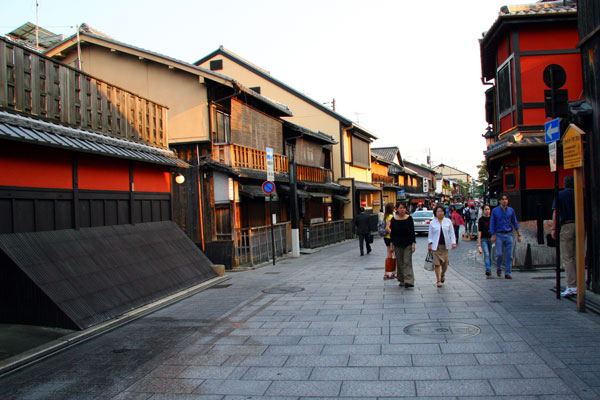 The Old Geisha Quarter of Hanami-Koji |
Tour Club - Dorms 2450 yen; Double w/Toilet+Shower 6890; Triple 8880. 10 minutes walk (or a short bus ride) from Kyoto Station.
Guest Inn Kyoto - 3500 yen for a private single w/Toilet+Shower; 7000 for a double; 10500 for a triple. A few minutes to Kyoto Station via Bus 206.
 Fox-faced Prayer Inscriptions at Fushimi Inari Shrine |
Business Hotels
Toyoko Inn - There are 3 branches in Central Kyoto, all within walking distance of subway or bus stations, and costs around 6000 yen for a Single and 8000 for a Double/Twin. IMHO the best locations is the Shijo-Karasuma branch, which costs a little more.
Superhotel - Located right beside subway's Gojo station, and costs about 6000 yen for single, 8000 for double, and 9000 for triple.
 Kodaiji Temple in Higashiyama District |
Mid-Range Hotels and Beyond
If this is your preference then perhaps you shouldn't be reading this article. Sorry :)
 Confectionist at Work |
Minshuku / Ryokan - with Private Bathroom
If you want the full Japanese experience of staying at a traditional inn, Kyoto is a nice place to do it and the cost isn't much more than a business hotel:
Ohto Ryokan - Near Sanjusangendo temple, a short bus ride from Kyoto Station via Bus 100 or 206. All rooms with private toilet and shower. Single 4725 yen; Double 9450; Triple 12600.
Iroha Ryokan - At heart of the tourist district of Higashiyama, walking distance from Sanjo-Keihan subway station. Triple room with toilet for 12000 yen.
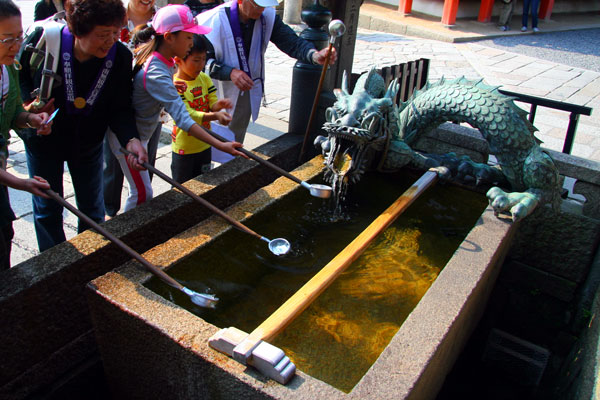 Cleanse Your Mouth at the Purifying Pool |
Kinsuikan - Walking distance to subway's Karasume-Oike Station. Single Room with Toilet/Shower 6000 yen; Double 9000; Triple 12000.
Ikoi no Ie - Single Room with Toilet/Shower 7600 yen; Double 9600; Triple 12600. Also has ensuite rooms costing a bit more. Walking distance to Gojo subway station.
 Most Paper Cranes I've Ever Seen in my Life |
Station Ryokan Seiki - Walking distance from Kyoto Station. Single Room with Toilet/Bath 5500 yen; Double 8000; Triple 12000.
Ryokan Shimizu - Walking distance from Kyoto Station. All rooms with private toilet/bath. 5000 yen per person for low season; 6000 for mid season; 7000 for peak season.
Ryokan Kyoraku - Walking distance from Kyoto Station. Single Room with Toilet/Bath 6000 yen; Double 11000; Triple 16000.
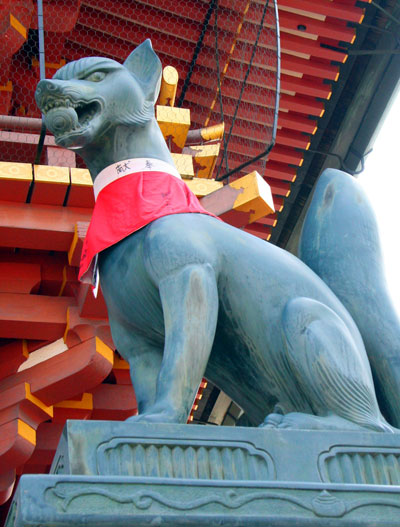 Object of Worship at Fushimi Inari Shrine -- the Fox |
Minshuku / Ryokan - without Private Bathroom
I collected these links but never seriously considered them since my wife wanted a private bathroom. Also be sure to find out how to get to these Ryokans, as some of them may be quite a long bus ride from Kyoto Station.
Sanki - Single Room 4200 yen; Double 8000.
Fujiya Ryokan - Double 9000 yen.
Rokuroku - Double 8400; Triple 10200.
Matsubaya - Single Room 5460 yen; Double 9870; Triple 13860.
Hinomoto - Single Room 4200 yen; Double 8400.
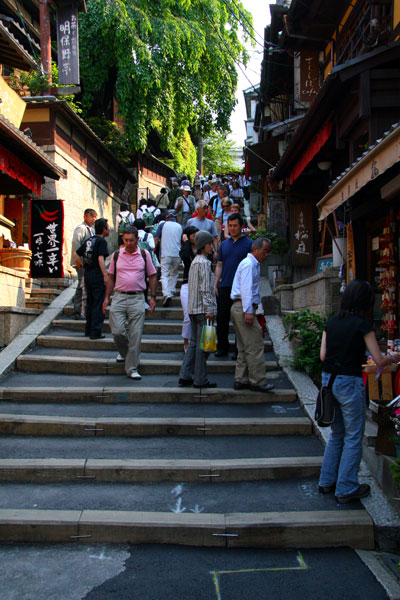 The Busy Sannen-zaka |
Kyoka - Single Room 4200 yen; Double 8400.
Hiraiwa - Single Room 4200 yen; Double 8400.
Miwaya - Double 10500.
Nunoya - Single Room 6825 yen.
Kyonoen - Double Room 8000 yen.
 Traditional Pottery Store outside Kodaiji Temple |
Machiya Rental
If you really want the ultimate Kyoto experience, you can rent an entire Japanese-style Townhouse (Machiya) for your stay.
Though not business-hotel-cheap, if you compare it to renting a villa in Tuscany or Provence you'll realize this is still quite a bargain.
Kyoto Machiya - the first English-language-friendly Machiya rental site. Judging from the photos the townhouses look really posh and comfy. Expensive though.
Tenshi Tsukinuke - You need some minimal Japanese knowledge to make your reservation here. But it costs only 20000 yen for up to 4 occupants.
Shindo-shokuryo - You also need some minimal Japanese knowledge to make your reservation here. There are several Machiyas for rent, and the cheapest costs only 15800 yen for up to 3 occupants.
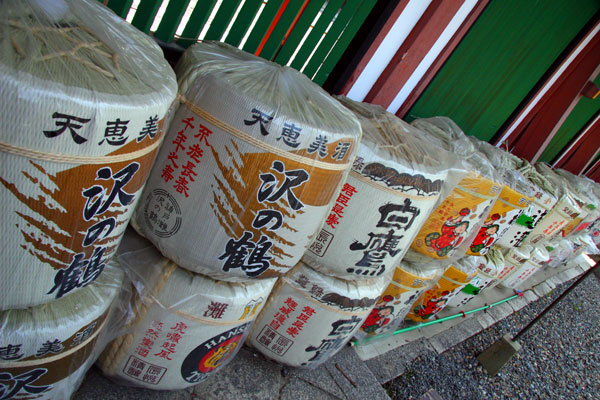 Sake Casks outside a Shrine |
Kyoto Eco-House Machiya
This is the ultimate ultimate Kyoto experience - a Kyoto-Style Machiya maintained and rented out by a grassroot non-profit group working for the preservation of traditional Japanese townhouses. We stayed here for three nights in May 2008, and IMHO this is the ultimate immersion into the authentic Kyoto.
 Eco-House Machiya -- Our Base for Exploring Kyoto |
This is a 90-plus-year-old Machiya built in the traditional style with a raised floor, wooden lattice windows, and sliding wooden panels dividing two small Tatami-mat rooms. For three days this became our own, and we became regular Kyoto residents, buying necessities from the neighborhood 100-yen shop, cooking breakfast over the gas burner, hand-washing our clothes and drying them on the backyard clothesline. And the real kicker is --- it costs less than 5000 yen (CAD$50) per night, with your own kitchen, fridge, a clean bath/shower and all.
For now I'll provide a quick link for anyone interested in making a reservation very soon. But I promise I'll write a proper article on this wonderful and unique alternative accommodation in central Kyoto. Soon.
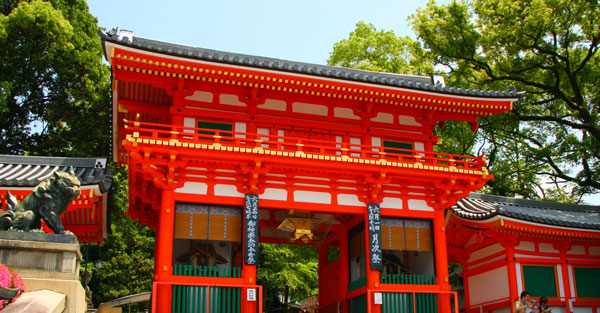 Yasaka Shrine at the Heart of Gion District |
BEST SEASON TO VISIT
I find that it really depends on how well you tolerate huge crowds. I mean seriously huge crowds.
The most popular seasons are:
- Sakura (cherry blossom) season in April
- Koyo (autumn foliage) season in mid-late November
- Festival season in July (Gion Matsuri) and August (Obon)
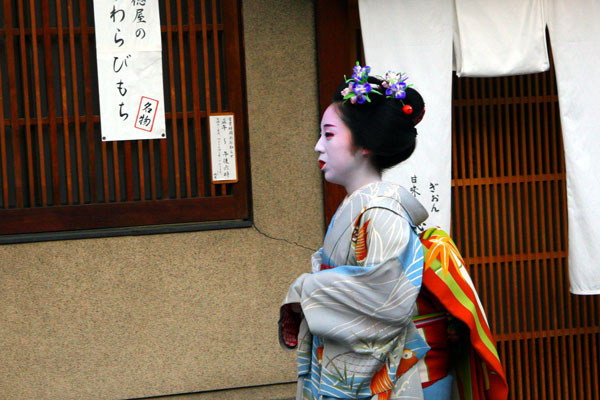 A real Maiko -- you can tell from her graceful manner and her quick bows to every picture-taking tourist and stopped car |
These are all beautiful times of the year to visit, as long as you're comfortable with the extreme crowdedness from foreign as well as domestic tourists at every popular sight. Also, summer in Kyoto is very hot and humid -- for the past several years the August average daytime temperature has reached 33-34 degrees Celcius with 60-plus percent humidity. The weather in Sakura and Koyo season is much nicer, with daytime temperature around 17-19 degrees Celcius and not too much rain.
 Hurrying Away to the Next Appointment |
For the other months of the year, late December to February are generally cold (daytime high of 10 degrees or less), but the airfare is cheapest, the city least crowded, and many hotels have low season rates. It begins to warm up in March, and the temperature stays quite comfortable up to late May; this is generally shoulder season except when the Sakura is in full bloom, however stay clear of the Golden Week domestic holiday in late April-early May. The Aoi Matsuri festival is held annually on May 15. The rainy season start mid June, which lasts until July when the hot humid weather kicks in and runs through September. July and August is also peak travel season for domestic tourists so hotel prices won't be cheap. The Jidai Matsuri festival is held on October 22, when the weather should be dry and cool, and by December it cools all the way down to single-digit temperature.
We ended up choosing mid May due to several factors: comfortable weather, reasonable airfare, medium level of crowdedness, and catching the Aoi Matsuri (May 15) was an added bonus.
 Tanuki Statues -- One of My Favorite Folk Craft Items |
FOOD
Please see my next article on Kyoto's local cuisine ... it's too long to put into this article.